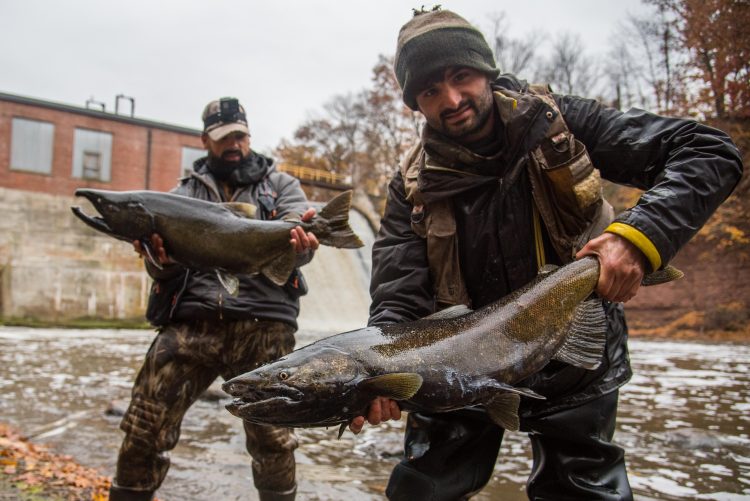The Other Migration | Fall Run Survival Guide
Each autumn, another major migration takes place in Lake Ontario's tributaries in upstate New York.

The fall run is a chaotic and wonderful time to be a striped bass angler. Even though fishermen throughout most of the Northeast can count on about two solid months of fishing for migrating stripers between Labor Day and New Year’s, there’s a “blink-and-you’ll-miss-it” feel that causes us to cast with a sense of urgency that wasn’t present back when the bass were migrating north.
To help make the most of this year’s fall striper migration, we’ve compiled this “Survival Guide” by surveying some of the most dedicated surfcasters in the Northeast and sharing some of our favorite tips for the final months of the striper season.
-Jimmy Fee
Rinse Off the Salt
Some of the most impressive fall migrations happen far from the salt water on Lake Ontario’s tributaries, where king salmon the size of cow stripers charge into rivers and creeks you could cast across.
The salmon runs are less dependent on the phase of the moon than they are the flow of rivers. In late August, after a three- to five-year feeding binge on alewives in Lake Ontario, king salmon from 10 to 30 pounds stage at the mouths of tributaries waiting for a boost in water levels brought on by early fall storms to make the charge.

Fishermen have their pick of nearly a dozen creeks and rivers that get runs of king salmon, but the “Montauk” of this freshwater fall run has to be the Salmon River in Pulaski, New York. Thousands of salmon run through 12 miles of public-access riverbank on the river, and fishermen from the Northeast (and from around the country), gather for the chance to battle fish averaging more than 15 pounds in a shallow river using relatively light gear.
While the kings aren’t exactly feeding on this journey, they are fiercely competitive, jockeying for space and attacking flies, plugs, and spinners that invade their personal space. A hooked king will charge downriver with even more power than a striped bass of the same size. Broken lines, bent hooks, and even emptied spools are a regular part of the Salmon River experience, which makes each fish brought to hand even sweeter.
Essential gear for the salmon run includes 8- to 10-weight fly rods, fly reels with smooth drags, and floating lines. Spinning rods of 8 to 10 feet rated up to 1 ounce and spooled with 12-pound-test mono are the go-tos for non-fly anglers. For both types of anglers, getting the offering to the bottom is key.
Boots with carbide-studded soles help navigate slick river rocks, and a net large enough to scoop a big striper is needed for the end game with a hooked king. When the salmon are running, the weather is generally mild, but it can be chilly during the pre-dawn stakeouts needed to ensure elbow room at the most popular locations.
Fishermen can keep up to three salmon apiece, and their meat can be grilled, baked, or smoked, but many more fish are returned to continue their upriver journey toward the Altmar Hatchery, where nearly all of Lake Ontario’s king salmon are produced.
Some saltwater fishermen flee to the Salmon River when tropical storms of the fall run make the seas unfishable for days at a time, but many more have a planned fall-run road-trip intermission to experience this unique fishery. Pulaski is well prepared for the seasonal influx of anglers, with lodging from $40/night for room rentals to the posher accommodations at Tailwaters Lodge.
Related Content
Winter Steelhead Fishing on the Salmon River
WATCH: King Salmon and Brown Trout in Lake Ontario Tribs – OTW’s Angling Adventures
1 thought on “The Other Migration | Fall Run Survival Guide”
-
John Been doing this for 17 yrs now.
I’d rather catch a 20-25 lb king than a striper of the same class.King will make a striper look bad in a fish.
Boy are stripers lazy, a 20yard run tops.
Salmon will go upstream in a 100yards faster than gronkowski could run a 100yrd downhill.
Then again.
What am I saying??Na, regular striper guys stay home.
I’m dumb, I don’t know what I’m talking about.
Salmon are not fun to catch at all.
Leave a Reply